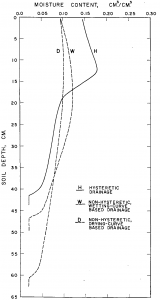8.1 Redistribution Within Partially Wetted Profiles
At the end of an infiltration event, the soil profile is often in a condition far from hydraulic equilibrium. Water continues to flow from the regions of higher water potential, that is the portion of the soil wetted during infiltration, to regions of lower water potential located farther from the infiltrating surface. Measured water content profiles during two different redistribution events for a clay soil are shown in Fig. 8‑1 [1]. The top portion of the figure shows redistribution following a 1.5 inch (3.8 cm) infiltration event. The wetting front had reached a depth of ~10 cm at the end of the infiltration event. During redistribution, water flowed out of the soil above that depth, and the water content decreased from ~0.44 cm3 cm-3 at the start of redistribution to ~0.32 cm3 cm-3 after one day. The water which flowed out of the infiltration-wetted portion of the soil flowed into the soil beneath, such that at the 12-cm depth, the water content increased from ~0.04 cm3 cm-3 at the end of infiltration to ~0.28 cm3 cm-3 after one day of redistribution. There was also a thin layer of soil centered on the 11-cm depth in which the water content increased after one hour of redistribution and then decreased after one day.

The data in Fig. 8‑1 help highlight some other key features of the redistribution process. You can see that the water content gradient associated with the wetting front diminishes over time during redistribution. Likewise, the matric potential gradient associated with the wetting front also diminishes over time, and this causes the rate of redistribution to decrease over time. Furthermore, as the water content decreases in the infiltration-wetted portion of the profile, the hydraulic conductivity of that soil decreases dramatically, and this also causes the rate of redistribution to decrease over time.

The process of soil water redistribution creates a dynamic situation where the infiltration-wetted part of the soil profile is getting drier while the neighboring parts of the soil are getting wetter. For this reason, the redistribution process is sensitive to hysteresis in the water retention curve. As you may recall from Section 3.3.3, the water content for any given matric potential is higher for the drying branch of the water retention curve than for the wetting branch (Fig. 3‑8). As a result, the infiltration-wetted part of the soil, the part which is getting drier during redistribution, retains more water than it would if hysteresis did not occur. This phenomenon is evident in the water content profiles in Fig. 8‑2, which were calculated using a numerical model of the redistribution process [2]. Thus, there are three mechanisms that may “help” the soil retain water near the soil surface after infiltration of rainfall or surface irrigation:
- the decreasing matric potential gradient,
- the decreasing hydraulic conductivity in the infiltration-wetted zone, and
- the effects of hysteresis.

